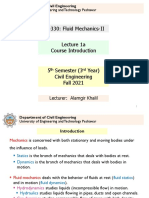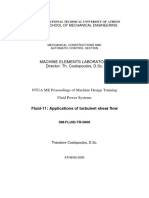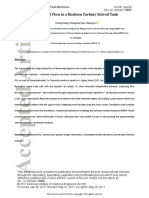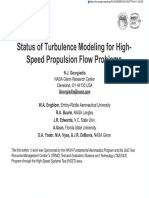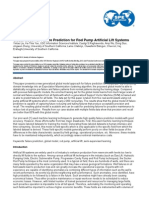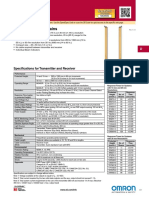Turbulent Flow
Turbulent Flow
Uploaded by
kamalCopyright:
Available Formats
Turbulent Flow
Turbulent Flow
Uploaded by
kamalOriginal Description:
Original Title
Copyright
Available Formats
Share this document
Did you find this document useful?
Is this content inappropriate?
Copyright:
Available Formats
Turbulent Flow
Turbulent Flow
Uploaded by
kamalCopyright:
Available Formats
www.Endbook.
net
Advanced Fluid Mechanics
www.Endbook.net
Sharif University of Technology
Department of Chemical and Petroleum Engineering
Advanced Fluid Mechanics
Prof. Davoud Rashtchiyan
Designed by:
F Bayati,
F. Bayati T.
T Hamzeloueian , A A. Noorjahan
E. Vafa, H. Taghdisian
www.Endbook.net
uid Meechaniccs
TURBULENT FLOW
ced Flu
Presented by:
P f D
Prof. D.Rashtchian
R ht hi
Advanc
A
Sharif University of Technology
Chemical & Petroleum Engineering Department
www.Endbook.net
An introduction to turbulent flow
Reynolds Experiment [11]
Advanc
A uid Meechaniccs
ced Flu
Sharif University of Technology
4 Chemical & Petroleum Engineering Department
www.Endbook.net
Advanc
A uid Meechaniccs
ced Flu An introduction to turbulent flow
Laminar flow in a pipe [11]
Movie 6-10 -- (t=10”)
Sharif University of Technology
5 Chemical & Petroleum Engineering Department
www.Endbook.net
An introduction to turbulent flow
Transition flow in a pipe [11]
Transition
Advanc
A uid Meechaniccs
ced Flu
M i 6-20
Movie 6 20 -- (t=12”)
(t 12”)
Sharif University of Technology
6 Chemical & Petroleum Engineering Department
www.Endbook.net
uid Meechaniccs An introduction to turbulent flow
Turbulent flow in a pipe [11]
Turbulent
ced Flu
Advanc
A
Movie 6-30 -- (t=8”)
Sharif University of Technology
7 Chemical & Petroleum Engineering Department
www.Endbook.net
uid Meechaniccs
Turbulent
ced Flu
Advanc
A
Transition from laminar to turbulent flow in a pipe [11]
Sharif University of Technology
8 Chemical & Petroleum Engineering Department
www.Endbook.net
Turbulent transport
p of momentum
Turbulence of random velocity fluctuations- Use statistical methods
Turbulent velocity u~i
uid Meechaniccs
u~i = U i + uˆi
Mean Fluctuating
Velocity Component
ced Flu
Advanc
A
Sharif University of Technology
9 Chemical & Petroleum Engineering Department
www.Endbook.net
Turbulent transport of momentum
Interpret Ui as a time averaged velocity defined by:
∫ ∫
T T
1 1
U i = lim u~i dt = lim (U i + uˆi )dt ≡ u~i
uid Meechaniccs
T →∞ T T →∞ T
0 0
1 1
∫ (U )dt = U
T T
uˆ i = lim
T →∞ T ∫0
uˆ i dt =U i − lim
T →∞ T 0
i i −Ui = 0
ced Flu
Advanc
A
Average of the fluctuations and average of the square of the fluctuations [11]
Sharif University of Technology
10 Chemical & Petroleum Engineering Department
www.Endbook.net
Turbulent transport
Turbulent p transport
of momentum [[11]]
of momentum
Turbulence of random velocity fluctuations- Use statistical methods
Turbulent velocity u~i
uid Meechaniccs
u~i = U i + uˆi
Mean Fluctuating
Velocity Component
Laminar
Diffusion
ced Flu
Turbulent
Diffusion
Advanc
Movie 6-40 -- (t=8”)
A
Sharif University of Technology
11 Chemical & Petroleum Engineering Department
www.Endbook.net
i.e. the mean value (or time average) of the fluctuating quantity is zero. Assume that
Ui the mean flow is steady (∂Ui/∂t = 0)
uid Meechaniccs
Note: Time averaging commutes w.r.t. differentiation.
∂u~i ∂u~i
=
∂x j T
1
∫
T
∂x j
dt =
∂
∂x j
⎧1
⎨ ∫
T ⎫ ∂U i
u~i dt ⎬ =
∂
=
∂
∂ ~
ui ( )
0
⎩T 0
⎭ x j x j
The time average of the fluctuation ûi is zero, but the average of the square of the
uˆi2
ced Flu
fluctuation is not zero and the quantity is used as a convenient measure of the
Ui
turbulent fluctuation-known as the "intensity of turbulence" and ranges from 0.01 to
0.1 for most turbulent flows.
(uˆ ) r.m.s. velocity.
Advanc
2
i
KE =
1
( 1
) (
ρ U i2 + uˆ i2 = ρ U i2 + uˆ i2 )
A
Mean K.E./unit volume = 2 2
mean flow + fluctuatio ns
Sharif University of Technology
12 Chemical & Petroleum Engineering Department
www.Endbook.net
Equations for the mean flow
Consider the momentum and continuity equations. These apply to the instantaneous velocity
in a turbulent field.
uid Meechaniccs
~ ∂u~i 1 ∂~
p ∂ 2 u~i
uj =− +ν
∂x j ρ ∂xi ∂x j ∂x j
∂u~i
=0 (1)
∂xi
The equations must apply on average
ced Flu
u~i = U i + uˆi
Continuity
Advanc
1 T ∂u~i ∂u~i ∂ ∂U i
lim ∫
T →∞ T 0 ∂x
dt = = (U i + uˆi ) = =0 (2)
i ∂ x i ∂x i ∂x i
A
The mean value satisfies continuity. It is the mean value of velocity that we measure and
require in applications.
Sharif University of Technology
13 Chemical & Petroleum Engineering Department
www.Endbook.net
Momentum:
The equations of motion for the mean flow Ui are obtained by taking the time average of all
terms in the resulting equation.
uid Meechaniccs
Consider each term:
∂u~i ⎛ ∂u~ j ⎞
~
(i) u j =
∂ ~~
∂x j ∂x j
~
(u j u i ) − u i ⎜
⎜ ∂x
{
⎟ = ∂ (U j + uˆ j )(U i + uˆ i ) }
⎝ j ⎠ ∂x j
=
∂
∂x j
{
U jU i + uˆ j uˆ i + U i uˆ j + U j uˆ i }
∂
{ } ∂U i ∂
ced Flu
= U iU j + uˆ i uˆ j = U j + (uˆ j uˆ i ) (2.1)
∂x j ∂x j ∂x j
1 ∂~
p 1 ∂ 1 ∂P
Advanc
(ii) − =− ( P + pˆ i ) = − (2.2)
ρ ∂x i ρ ∂x i ρ ∂x i
∂ 2 u~i ∂2 ∂ 2U i
((iii)) ν =ν (U i + uˆi ) = ν ((2.3))
∂x j ∂x j ∂x j ∂x j ∂x j ∂x j
A
Sharif University of Technology
14 Chemical & Petroleum Engineering Department
www.Endbook.net
Hence
∂U i 1 ∂P ∂ 2U i ∂
Uj =− +ν − (uˆ j uˆ i ) (3)
∂x j ρ ∂xi ∂x j ∂x j ∂x j
uid Meechaniccs
Equation for mean flow has an additional term.(Drop the ^ ⇒ uˆ j uˆi = u j ui )
∂u j u i ∂U i
Term is analogous to the convective term U j ;
∂x j ∂x j
It represents the mean transport of fluctuating momentum by turbulent velocity
fluctuations.
If ûi and û j uncorrelated i.e. u j ui = 0 - no turbulent momentum transfer but
ced Flu
experience shows that u j ui ≠ 0 - momentum transfer is a key feature of turbulent
motion.
∂
Term (uˆ j uˆi ) thus exchanges
g momentum between the turbulence and the mean
∂x j
Advanc
flow (equation 2.1)even though the mean momentum of the turbulent velocity
fluctuations is zero ( ρ uˆi = 0 ).
A
Sharif University of Technology
15 Chemical & Petroleum Engineering Department
www.Endbook.net
Because of the decomposition u~i = U i + uˆ i , turbulent motion can be perceived as something which
produces stresses in the mean flow. For this reason, equation (3) may be rearrange so that all stress
can be put together.
uid Meechaniccs
∂U i ⎛ ⎡ ∂U j ⎤ ⎞ ∂
ρU j =
∂ ⎜ − Pδ + µ ⎢ ∂U i + − ρ ⎟ (T ji ) - mean stress tensor.(τ~ = T + τˆ )
j i =
⎥ ˆ
u ˆ
u
∂x j ∂x j ⎜ ji
⎢⎣ ∂x j ∂xi ⎥⎦ ⎟ ∂x j
⎝ ⎠
⎡ ∂U ∂U j ⎤
T ji = − Pδ ji + σ ji − ρ uˆ j uˆi ; σ ji = µ ⎢ i + ⎥
∂
⎣⎢ j
x ∂x ⎥
i ⎦
(
(normal)
l) (shear)
(h )
ced Flu
The contribution of the turbulent motion to the mean stress tensor is σ Tji = − ρ u j ui called the
Reynolds stress tensor. Define Ω ji = σ ji + σ Tji
tensor Define,
Advanc
A
Sharif University of Technology
16 Chemical & Petroleum Engineering Department
www.Endbook.net
Turbulent shearing stresses
Time averaging of the equations of motion leads to the Reynolds stress tensor, ρ uˆ j uˆi .
uid Meechaniccs
u i and uû j are the velocity fluctuations in the i ≠ j directions at one point and ui u j is a
û
measure of the "correlation" between the fluctuations.
Correlated variables
u~i u~ j = (U i + uˆi )(U j + uˆ j ) = U iU j + ui u j
ced Flu
If ui u j ≠ 0 , ûi and û j are said to be correlated i.e. dependent.
If ui u j = 0 , uncorrelated i.e. ûi and û j are independent.
Advanc
A
Sharif University of Technology
17 Chemical & Petroleum Engineering Department
www.Endbook.net
uid Meechaniccs
ced Flu
Fig2(a) Fig2(b) Fig2(c)
u1u 2 > 0 u1u 2 < 0 u1u 2 ≈ 0
Advanc
R12 = 1 R12 = −1 R12 ≈ 0
A
Sharif University of Technology
18 Chemical & Petroleum Engineering Department
www.Endbook.net
uˆ1uˆ 2
{uˆ .uˆ }
A measure of the degree of correlation between û1 and û 2 is obtained from: 1
2 2 2
1 2
1
uid Meechaniccs
1 T uˆ1uˆ 2 ⎧ 1 T 2 ⎫
( )
2
R12 = lim ∫ dt : ui = ui = ⎨ lim ∫ uˆi dt ⎬
′ ˆ 2
T →∞ T 0 u ′u ′
1 2 ⎩T →∞ T 0 ⎭
uˆ uˆ
R12 = 1 2
u1′u2′
1 2
N.B. (a − b) ≥ 0 ⇒ (a + b ) ≥ ab
2 2
2
ced Flu
1 1 T ⎧⎪ uˆ12 uˆ22 ⎫⎪
Hence R12 ≤ lim ∫ ⎨ + ⎬dt ≤ 1
2 T →∞ T 0 ⎪⎩ uˆ12 uˆ22 ⎪⎭
Advanc
A
Sharif University of Technology
19 Chemical & Petroleum Engineering Department
www.Endbook.net
Pure shear flow
Consider a turbulent shear flow with U1(x2) the only non-zero velocity component.
∂U
Ω12 is the only component of the mean stress tensor, Ω12 = µ 1 − ρ uˆ 2 uˆ1
∂x2
uid Meechaniccs
Ω12 – stress
t in
i 1 direction
di ti on face, f normall in
i 2 direction
di ti and d mustt result
lt from
f
molecular transport of momentum in the x2 direction, and turbulent transport.
∂U 1
Assume >0.
∂x2
A fluid particle with positive û 2 is being carried by turbulence in positive x2
direction. It is coming from a region where the mean velocity is smaller i.e. is likely
to be moving downstream more slowly than its new environment. Thus û1 is negative.
Si il l negative
Similarly i ûˆ 2 associated
i d with i i ûˆ1 .
i h positive
ced Flu
************************
Fig3
Advanc
A
Sharif University of Technology
20 Chemical & Petroleum Engineering Department
www.Endbook.net
{Momentum/unit volume of flow at A in 1-direction} = ρu~1 = ρ (U 1 + uˆ1 )
The x1-momentum is transported in the x2-direction if u1 and u2 are correlated.
uid Meechaniccs
{Flux of x1-momentum in x2-direction} = ρ (U 1 + uˆ1 )uˆ 2
g flux of x1-momentun in x2-direction}} = ρ uˆ1uˆ 2
{{Average
û1 and û 2 are negatively correlated: σ 12T = σ 21
T
= − ρ u 2 u1
ced Flu
Advanc
A
Sharif University of Technology
21 Chemical & Petroleum Engineering Department
www.Endbook.net
Turbulent Channel Flow
uid Meechaniccs
Th Navier-Stokes
The N i St k equations
ti iin rectangular
t l coordinates
di t are
∂U i 1 ∂P ∂ 2U i ∂
Uj =− +v − (ui u j )
∂x j ρ ∂xi ∂x j ∂x j ∂x j
For parallel, fully developed, 2 D flow
ced Flu
U2 = U3 = 0 ⎫
⎪
∂U i ∂U i ⎬ ∴ L.H .S . = 0
=0; = 0⎪
∂x1 ∂x3 ⎭
Advanc
∂ ∂
(ui u j ) = 0 ; (ui u j ) = 0
∂x1 ∂x3
A
Sharif University of Technology
22 Chemical & Petroleum Engineering Department
www.Endbook.net
Hence the equations can be written in the simplified form,
uid Meechaniccs
1 ∂P ∂ 2U ∂
0=− + v 2 − (uv) (1)
ρ ∂x ∂y ∂y
1 ∂P ∂ 2
0=− − (v ) (2)
ρ ∂y ∂y
ced Flu
At the walls v 2 = 0, P = P0(x) . Hence form (2)
P0 P
Advanc
= + v2 (3)
ρ ρ
A
∂P ∂P0 dP0
= = (4)
∂x ∂x dx
Sharif University of Technology
23 Chemical & Petroleum Engineering Department
www.Endbook.net
Hence (1) can be integrated from y
y=0
0 to y with uv =0
y =0
y dP0 ∂U ∂U
0=− ( )+v −v + uv (5)
uid Meechaniccs
ρ dx ∂y ∂y y =0
At y=h, uv=0, ∂U / ∂y = 0 (zero velocity gradient, no correlation)
τw h dP µ ∂U
=− ( 0)= (6)
ρ ρ dx ρ ∂y
ced Flu
y =0
Defining a friction velocity u*
Advanc
τ w = ρ u∗2 (7)
A
Substituting in (5)
∂U y
− uv + v = u *2 (1 − ) (8)
∂y h Sharif University of Technology
24 Chemical & Petroleum Engineering Department
www.Endbook.net
Equation (8) may be written in dimensionless form in 2 ways.
ways
− uv v d (U / u* ) y
+ = (1 − )
uid Meechaniccs
(I) 2
u* u*h d ( y / h) h
R* =u* h/v.
h/v As R* becomes large
large, (R* is of course a Reynolds number)
number), the
viscous stress is suppressed. Such a limit will not applied because viscous
forces must always dominate near solid boundaries.
ced Flu
uv d (U / u* ) yu* v
(II)
− 2+ = 1− .
u* d ( yu* / v) v hu*
Advanc
In this case as R* becomes large the change in total stress becomes small.
Defining appropriate dimensionless variables
A
Sharif University of Technology
25 Chemical & Petroleum Engineering Department
www.Endbook.net
yu * U y
y+ = ; u+ = ; η=
v u∗ h
uid Meechaniccs
Then
uv 1 du +
− + * = 1 −η (11)
u* R dη
2
uv du + y+
− + = −
ced Flu
1 (12)
u*2 dy + R*
Law of wall
Advanc
For large R* (from 12)
uv du +
A
− 2
+ =1 (13)
u* dy +
Sharif University of Technology
26 Chemical & Petroleum Engineering Department
www.Endbook.net
The solution of this equation must be of the form,
uv
− = g ( y +) ; u + = f ( y +)
uid Meechaniccs
2 (law of the wall) (14)
u*
For sufficiently small y+, turbulent stress negligible.
du +
d
=1 ; with u+(0)=0 (15)
dy +
ced Flu
u+ = y+
Core region
Advanc
For large R* (from 11)
uv
= (1 − η )
A
− 2
u∗
Sharif University of Technology
27 Chemical & Petroleum Engineering Department
www.Endbook.net
This equation gives no information, about U itself. However h and u* are the only feasible
length and velocity scales, we can write
dU u * dF
= Where F(η ) is some function of η . (17)
uid Meechaniccs
dy h dη
Integration from the center where U=U0
U −U0
= F (η ) (18)
u*
ced Flu
From equation (14),
U dU u *2 dff ( y +)
= f ( y +) ; =
Advanc
(19)
u* dy v dy +
Matchingg ((17)) & ((19),
),
A
u∗ dF u∗2 df dF df 1
. = ; η = y+ + = (20)
h dη ν dy + dη dy K
Sharif University of Technology
28 Chemical & Petroleum Engineering Department
www.Endbook.net
1 1
F (η ) = ln η + const. f ( y +) = ln y + + const.
K K
Hence
uid Meechaniccs
U −U0 1 U 1
= ln η + const. = ln y + + const.
u* K u* K
Discussion
y+
ced Flu
To simplify (12) to (14) requires = η 〈〈 1 (a)
R*
1 du +
To simplify
p y ((11)) to ((16)) requires
q 〈〈 1 − η ((b))
R * dη
Advanc
Matching only possible if y+ → ∞
η →0
A
⎧ y + > 100
In practice it is found that ⎨ are sufficient
⎩η < 0.1
Sharif University of Technology
29 Chemical & Petroleum Engineering Department
www.Endbook.net
y+
uid Meechaniccs
Now η < 0.1 ; ∴ < 0.1 (cf.(a))
R*
And y + > 100 ∴ηR* > 100
∴ R* > 100 / η
η < 0.1
∴R* > 1000
Experimentally
ced Flu
du + 2.5
=
dη η
1 du + 2.5
∴ =
Advanc
R * dη R *η
1 du + 2.5
H
Hence = << (1 − η ) ( cff . (b))
A
R * dη R *η
Sharif University of Technology
30 Chemical & Petroleum Engineering Department
www.Endbook.net
df 1
y+ =
uid Meechaniccs
Also from (20)
dy + K
1
∴ f ( y + ) = ln( y + ) + const. (21)
K
Experimentally
U −U0
ced Flu
= 2.5 ln η − 1.0
u*
Advanc
U
= 2.5 ln y + + 5.0
u*
A
Sharif University of Technology
31 Chemical & Petroleum Engineering Department
www.Endbook.net
Application
1. For Engineering Purposes these
uid Meechaniccs
equations have been used for η > 0.1 ,
i.e. to describe the core region, and
also for η → 0 . Note as
η → 0 , u + = U / u* → −∞∞
2. Sometimes the Universal Velocity
pprofile is used.
ced Flu
Equn. (15) u+=y+ for y+ ≤ 5
Equn. (21) u+=2.5lny++5.0for y+ ≥ 30.
Advanc
Limits determined experimentally.
A curve fit for 5<y+<30
Is u+=5.0 ln y+ - 3.05
A
Sharif University of Technology
32 Chemical & Petroleum Engineering Department
www.Endbook.net
uid Meechaniccs
ced Flu
Advanc
A Laminar & turbulent flow in pipes [13]
Movie 6-50 -- (t=4’:27”) Sharif University of Technology
33 Chemical & Petroleum Engineering Department
www.Endbook.net
Example of use of turbulent velocity profiles.
profiles
momentum transfer
uid Meechaniccs
τω 2u *2
Friction factor f = = 2
1 U
ρU 2
2
Using the velocity defect law for flow in a tube
ced Flu
y =h
1 ⎡U − U 0 ⎤ U −U0
πh 2 ∫y =0 ⎣⎢ u* ⎥⎦ . 2πrdy =
u*
Advanc
η =1
2πr
= ∫
η = 0 πh
2
h{2.5 ln η − 1}dη
A
Now r=h-y ; η = y / h → dy = hdη ; r = h(1 − η )
Sharif University of Technology
34 Chemical & Petroleum Engineering Department
www.Endbook.net
η =1
(U − U 0 )
Hence = ∫ 2(1 − η ){2.5 ln η − 1}dη
u* η =00
Also from experimental results
uid Meechaniccs
U0 U
= − 2.5 ln η + 1.0
u* u*
= 2.5 ln y + − 2.5 ln η + 1.0 + 5.0
= 2.5 ln R * +6.0
hu * h fU 2 Re f
R* = = =
ced Flu
v v 2 2 2
U0 Re f
= 2.5 ln[
l [ ]+6
Advanc
u* 2 2
U Re f 5η 2 5η 2 η 2 1
= 2.5 ln[ ] + 6 + [5η ln η − 5η − 2η − ln η + + ]0
u* 2 2 2 4 2
A
1 ⎧ Re f ⎫
= 4.07 log 10 ⎨ ⎬ + 0.53
f ⎩ 2 2⎭
Sharif University of Technology
35 Chemical & Petroleum Engineering Department
www.Endbook.net
Mass transfer: Turbulent Taylor Analysis. Proc. Royal. Soc. (1954), A223,
P446, for Axial Dispersion in turbulent pipe flow.
uid Meechaniccs
Consider diffusion equation in rectangular coordinates for simplicity.
ced Flu
Advanc
A
Sharif University of Technology
36 Chemical & Petroleum Engineering Department
www.Endbook.net
Turbulence in pipe flows
Scope of Turbulence
uid Meechaniccs
Most flows in nature: rivers
rivers, the atmosphere
Engineer: pipe flow, packed and plate column
Pipe Flow
ced Flu
Advanc
Laminar sublayer - viscous forces dominate, very thin
T
Transition
iti region
i - region
i off damped
d d tturbulence
b l because
b off nearby
b wall,
ll
A
eddy size y.
Turbulent core - region of fully developed turbulence, eddies of size d,
velocity nearly constant.
Sharif University of Technology
37 Chemical & Petroleum Engineering Department
www.Endbook.net
Turbulent Velocities
- local downstream velocity fluctuates due to turbulent eddies .decompose
u t = u + uˆ
uid Meechaniccs
⎛ Instantane us ⎞ ⎛ local mean ⎞ ⎛ eddy ⎞
⎜⎜ ⎟⎟ = ⎜⎜ ⎟⎟ + ⎜⎜ ⎟⎟
⎝ velocity ⎠ ⎝ velocity ⎠ ⎝ velocity ⎠
ced Flu
- definition of u (mean velocity)
1 T
u=
T ∫0
u t dt
Advanc
- clearly the average of the eddy velocity is zero
T T T
1 1 1
u = ∫ (u + uˆ )dt = ∫ udt + ∫ uˆdt
A
T 0 T 0 T 0
T
1
T ∫0
uˆdt = 0
Sharif University of Technology
38 Chemical & Petroleum Engineering Department
www.Endbook.net
- the magnitude of turbulent velocities is characterized by the RMS
-
1
uid Meechaniccs
⎡1 2 ⎤ 2
T
u ′ = ⎢ ∫ uˆ dt ⎥
⎣T 0 ⎦
((RMS fluctuatingg or eddyy velocity.)
y)
- the turbulence intensity is defined by,
u′
turbulent intensity = (typically up to 0.1)
0 1) i.e.
i e the average eddy velocity
ced Flu
u
may be 1/10 of the mean velocity.
Advanc
A
Sharif University of Technology
39 Chemical & Petroleum Engineering Department
www.Endbook.net
Properties of turbulent flows
(with particular reference to pipe flows)
uid Meechaniccs
1) Irregularity local velocities fluctuate in random manner. But all
turbulent flows are irregular. E.g. smoke plume.
2) 3D Nature pipe flows are normally considered as 1 dimension in
that downstream velocity depends only on radius. However in
ced Flu
turbulent flows normal velocity components, though zero on average,
have fluctuating components, ( Vˆ and Ŵ ). These give rise to
turbulent stresses (remember the mail bag example) and are important
Advanc
in turbulent energy processes. This 3D nature adds the mathematical
difficulty.
A
Sharif University of Technology
40 Chemical & Petroleum Engineering Department
www.Endbook.net
3) Turbulence is a property of the flow not of the fluid. Writing
Newton’s law for a flow involving turbulent stresses.
uid Meechaniccs
τ du
= −(ν +ν T ) ; [divided by ρ ]
ρ dy
µ
Where ν = is the kinematics viscosity .
[L]
2
ρ [T ]
ν T = eddy viscosity
ced Flu
In laminar sub layer ν T << ν
Transition region νT ~ν
Turbulent core ν T >> ν
Advanc
Thus υT varies with environment and is a flow property.
A
Sharif University of Technology
41 Chemical & Petroleum Engineering Department
www.Endbook.net
4) Mixing in turbulent flows-diffusivity
Rewrite Newton’s law in the form, explicit in shear stress.
uid Meechaniccs
d (ρu )
τ = −(ν +ν T )
dy
[M ][U ] 3
Dimensions :
[M ][U ] = [L] .
2
[L]
[L]2 [T ] T [L]
ced Flu
i.e. (momentum flux) = (diffusivity) * (gradient of momentum / volume)
Advanc
- this fundamental relation shows how transport (here of momentum) is related
to the driving force (momentum gradient).the coefficient, υ , is the momentum
diffusivity.
y It shows how large
g a flux is produced
p byy a given
g gradient.
g Exactlyy
A
analogous laws apply for heat transfer (Fourier's Law) and mass transfer
(Flick's law).
Sharif University of Technology
42 Chemical & Petroleum Engineering Department
www.Endbook.net
- Now ν T ff ν in turbulent flows.
uid Meechaniccs
Turbulent is a very effective mixer of momentum which accounts for
the almost constant velocity of the core region will usually be of almost
constant temperature and composition.
But ν ff ν T in laminar sublayer.
ced Flu
Advanc
A
Sharif University of Technology
43 Chemical & Petroleum Engineering Department
www.Endbook.net
In laminar flow it is the molecular motion which transports momentum.
(Remember mail bag example). Hence lower rates of transport for a given
uid Meechaniccs
driving force.
force Alternatively if we consider heat transfer from the wall to
bulk, heat conduction across the laminar sub layer dominates the process
(Heat transfer comes later).
- Pictorially
ced Flu
Eddy gives rise to normal velocity Vˆ .
This transports x directional momentum
in the y direction gives rise to a
Advanc
momentum flux, or shear, τ .
A
Sharif University of Technology
44 Chemical & Petroleum Engineering Department
www.Endbook.net
5) Dissipative Nature of Turbulence.
- Turbulence comprises eddies of all sizes.
uid Meechaniccs
- The largest eddies are as big as the flow field. They extract energy from the
flow but are not efficient at dissipating energy. In the absence of an energy
source, however, turbulence dies away .
- There
Th is
i an energy cascade d from
f the
th large
l eddies,
ddi through
th h eddies
ddi off
progressively smaller size until a lower limit is reached. This lower limit is
controlled by viscous dissipation of energy and Kinematics viscousity and the
rate of energy supply are the important quantities.
quantities Based on dimensional analysis
ced Flu
this lower limit of eddy size is given by:
3
η ⎡ν ⎤ 4
Advanc
=⎢ = Re −3 4
d ⎣ u ′d ⎥⎦
Wh
Where η = size
i off smallll eddies;
ddi ν = kinematics
ki i viscosity
i i
A
d = size of largest eddies; u' = RMS turbulent velocity
Sharif University of Technology
45 Chemical & Petroleum Engineering Department
www.Endbook.net
uid Meechaniccs
ced Flu
surface ⎛s⎞
dissipatio n rate ∝ ⎜ ⎟
volume ⎝v⎠
Advanc
⎛s 6⎞ ⎛s 6d 2 12 ⎞ ⎛s 6d 2 24 ⎞
(i ) ⎜ = ⎟ (ii ) ⎜⎜ = 8 × d 3 = ⎟⎟ (iii ) ⎜⎜ = 64 × d3 = ⎟⎟
⎝v d ⎠ ⎝v 4 d ⎠ ⎝v 16 d ⎠
A
Sharif University of Technology
46 Chemical & Petroleum Engineering Department
www.Endbook.net
High Reynolds number phenomenon
uid Meechaniccs
- Express Newton
Newton'ss Law of viscosity in dimensionless form.
form
τ =
+ τ
=−
µd du
=−
1 d u (u )
=−
1 du +
ρu 2
ρu d dy
2
Re d ⎛ y ⎞
⎜ d⎟
Re dy +
⎝ ⎠
ced Flu
Reynolds's number arises in dimensionless form of Newton's Law.
- Similarity: compare two flows in similar geometries(same shape but
different size)i.e.
) flows exhibiting g geometrical
g similarity.
y Suppose
pp
Advanc
Reynolds numbers of each flow are the same though d,u, ρ and µ of
each flow may be individually different. Then as a consequence of the
q
above equation each flow will have the same dimensionless distribution
A
of stress and velocity gradient as a function of position,
Sharif University of Technology
47 Chemical & Petroleum Engineering Department
www.Endbook.net
Provided each has the same Reynolds number;
i.e. u+ = f(y+) kinetic similarity
τ+ = g(y
g(y+)) dynamic
y similarity.
y
uid Meechaniccs
The consequence is that friction factor (dimensionless wall shear stress) can be
considered a unique function of Re.
Consider a cylindrical element of diameter d and length of δx
du
Viscous forces ∝ µ .πdδx
dr
ced Flu
πd 2 du
Interia forces ∝ ρ δx
4 dt
Advanc
InteriaForces ρd dr
∝ ≡ Re
ViscousForces µ dt
A
High Re-interia forces dominate → Turbulent flow
Low Re-viscous forces dominate → Laminar flow
Sharif University of Technology
48 Chemical & Petroleum Engineering Department
www.Endbook.net
Summery Notes on Turbulence
• Most flows are turbulent both in nature and engineering.
• A turbulent pipe flow can be divided into three regions:
uid Meechaniccs
a)) Laminar sublayer
y - no eddies.
b) Transition region – damped eddies (size y)
c) Turbulent core – undamped eddies (size d)
• Turbulent
T b l velocities:
l ii
ut = u + uˆ {Instantaneous = local mean + fluctuant}
T
1
u = ∫ ut dt {T is a time long enough to include many eddies}
ced Flu
T 0
1 2 12
T
u ′ = [ ∫ uˆ dt ] {RMS velocity characterizes turbulence}
T 0
Advanc
u ′ ≅ v′ ≅ w′ {Turbulence is homogenous}
u ′ / u ≅ 0.1 {Turbulence intensity}
A
• Newton's Law in turbulent flows. It is tempting to write
du ⎧ν − Kinematic Vis cosity for Molecular
τ / ρ = −(ν +ν t ) ⎨
dy ⎩ν t − Eddy Vis cosity for Turbulence
Sharif University of Technology
49 Chemical & Petroleum Engineering Department
www.Endbook.net
ν is a fluid property and constant.
constant
νt is a flow property and depends on environment (eddy size)
• Rewrite above equation as
uid Meechaniccs
•
d ( ρu ) [ M ] [ L]
τ = −(v + vt ) dimensions
dy [ L]2 [T ]2
(momentum flux) = (momentum diffusivity)(gradient of mom/vol)
g ν implies
Large p rapid
p mixing. g Diffusivity [ ]2/[T]
y has dim. [L] [ ]
ced Flu
νT >> ν : Turbulent flows are rapidly mixed due to eddies.
• Energy in turbulent flows: turbulent dissipates considerable energy.
Advanc
Large eddies take energy from mean flow, but are not efficient in
dispersing energy. Small eddies do dissipate energy efficiently. There
is a transfer of energy to the small eddies, which appears as heat due to
f i i l effects.
frictional ff
A
Smallest eddy size, η, is given by ( dimensional analysis)
−3
η u ′d 4
= ( ) {η is also a good estimate of laminar sub sub-layer
layer thickness}
d v
Sharif University of Technology
50 Chemical & Petroleum Engineering Department
www.Endbook.net
• Rynolds Number arises in Newton's Law in dimensionless form
uid Meechaniccs
τ µ ddu µ d (u / u ) 1 ddu +
τ =
+
=− =− =−
ρu 2
ρu dy
2
ρu d d ( y / d )
2
Re dy +
It may be
b interpreted
i t t d as the
th ratio
ti (interia
(i t i forces
f / viscous
i forces).
f )
• Large Re implies dominance of interia forces which promote turbulence.
Small Re will dominance of friction (viscous) forces gives laminar flows.
Similarity (Consider different flows of same Reynolds Number) If we have
ced Flu
geometric similarity (e.g. two different pipe flows) then we will have
kinematic similarity (same du+/dy+) and dynamic similarity (same τ+).
Advanc
Result
f = τw+ = f(Re)
A
Sharif University of Technology
51 Chemical & Petroleum Engineering Department
www.Endbook.net
References
1 – Bird, B. R., Stewart, W. E., Lightfoot, E. N., “Transport phenomena”, Second
rn Fluiid Mecchanicss
Ed., John Wiley & Sons, 2002.
2 – Bennett, C.O. and Myers, J.E., “Momentum, Heat and Mass Transfer”,
M G
McGraw-Hill,
Hill 1982.
1982
3 – Fahien, R.W., “Fundamentals of transport phenomena”, McGraw-Hill, 1983.
4 – Rohsenow,
R h W M andd Choi,
W.M. Ch i H.Y.,
H Y “Heat,
“H t Mass
M andd Momentum
M t T
Transfer”,
f ”
Prentice Hall, 1961.
5 – Hin-Ze,
Hin Ze J.O.,
J O “Turbulence
Turbulence, an introduction to its mechanism and theory
theory”,
Moder
McGraw-Hill, 1959.
M
6 – Douglas,
Douglas J.D.,
J D et.
et Al.,
Al “Fluid
Fluid Mechanics
Mechanics”, Pitman,
Pitman 1985.
1985
7 – Wilkinson, M.A., “Non Newtonian Fluids”, Pergamon Press, 1960.
Sharif University of Technology
52 Chemical & Petroleum Engineering Department
www.Endbook.net
References
8 - Schlichting, H., “Boundary layer theory”, 7th Ed., McGraw-Hill, New York,
1979.
1979
rn Fluiid Mecchanicss
9 – Sissom, L.E., and Pitts, D.R., “Elements of transport phenomena”, McGraw-
Hill, 1972.
10 – White, F.M., “Viscous fluid flow”, 2nd Ed., McGraw-Hill, 1986.
11 – Munson,, B.R.,, et. Al.,, “Fundamentals of fluid mechanics”,, Fifth ed.,, John
Wiley & Sons, 2006.
12 – Shames, I.H., “Mechanics of fluids”, McGraw-Hill, 1982.
Moder
13 – Iowa Institute of Hydraulic research, IHR.
M
Sharif University of Technology
53 Chemical & Petroleum Engineering Department
You might also like
- Dnaman Sequence Analysis SoftwareDocument17 pagesDnaman Sequence Analysis SoftwarekamalNo ratings yet
- SheaveDocument13 pagesSheaveGer Bos0% (1)
- Vector and TensorDocument66 pagesVector and TensorkamalNo ratings yet
- CE-330: Fluid Mechanics-II Lecture 1a Course Introduction: University of Engineering and Technology PeshawarDocument17 pagesCE-330: Fluid Mechanics-II Lecture 1a Course Introduction: University of Engineering and Technology PeshawarAtif Khan GI CivilNo ratings yet
- 05-Dinamika Fluida Lanjut - Turbulent FlowDocument17 pages05-Dinamika Fluida Lanjut - Turbulent FlowSri Peni WijayantiNo ratings yet
- FM II Introduction Lect 1aDocument13 pagesFM II Introduction Lect 1aSajad HussainNo ratings yet
- Applications of Turbulent Shear FlowDocument255 pagesApplications of Turbulent Shear FlowMr. A.ENo ratings yet
- A Numerical Study On The Performance of A Superhydrophobic CoatedDocument14 pagesA Numerical Study On The Performance of A Superhydrophobic CoatedSoheil FazelNo ratings yet
- Shao 2021Document17 pagesShao 2021feng93873No ratings yet
- IAHR2002_nicoletDocument9 pagesIAHR2002_nicoletSwar PandNo ratings yet
- Edited Advance AerodynamicsDocument3 pagesEdited Advance AerodynamicsAADITYA SHAHNo ratings yet
- Boundary Layer TheoryDocument76 pagesBoundary Layer Theorysahel mamlekat doustNo ratings yet
- Transitional Flow in A Rushton Turbine Stirred TankDocument35 pagesTransitional Flow in A Rushton Turbine Stirred Tankricardo del rioNo ratings yet
- 1 s2.0 S0029549315002290 Main - NED - FourtharticleDocument13 pages1 s2.0 S0029549315002290 Main - NED - FourtharticlePratap SathiahNo ratings yet
- ESPE Paper ConfDocument6 pagesESPE Paper ConfStalynMEcNo ratings yet
- Status of Turbulence Modeling For High-Speed Propulsion Flow ProblemsDocument57 pagesStatus of Turbulence Modeling For High-Speed Propulsion Flow ProblemsKevin RussellNo ratings yet
- Steering Turque Determination of Pulling Open Thruster - 1Document20 pagesSteering Turque Determination of Pulling Open Thruster - 1조범석No ratings yet
- Escuela Profesional de Ingeniería Mecánica: Año Del Diálogo Y La Reconciliación NacionalDocument16 pagesEscuela Profesional de Ingeniería Mecánica: Año Del Diálogo Y La Reconciliación NacionalKevin AlejandroNo ratings yet
- Ch-1 Nozzles PDFDocument69 pagesCh-1 Nozzles PDFCh. Muhammad UsamaNo ratings yet
- Faculty of Engineering Fluid Mechanics Dr. Eng. Hasan HamoudaDocument12 pagesFaculty of Engineering Fluid Mechanics Dr. Eng. Hasan HamoudaHazem AlmasryNo ratings yet
- Cavitation Tests of Hydraulic Machines - Procedure and InstrumentationDocument12 pagesCavitation Tests of Hydraulic Machines - Procedure and InstrumentationanacatarinabarradasNo ratings yet
- Francis-99 Workshop 3: Fluid Structure Interaction: Journal of Physics: Conference SeriesDocument8 pagesFrancis-99 Workshop 3: Fluid Structure Interaction: Journal of Physics: Conference Seriespbs9890271109No ratings yet
- Lecture 6 Turbines - IIDocument54 pagesLecture 6 Turbines - IIAbram KhanNo ratings yet
- Ch-1 Complete Thermo-II Sp-20 PDFDocument71 pagesCh-1 Complete Thermo-II Sp-20 PDFFatima KhanNo ratings yet
- 3D Engineering Model of Downburst Evolution in Thunde 2011 Procedia EngineerDocument10 pages3D Engineering Model of Downburst Evolution in Thunde 2011 Procedia EngineerEnsar OğuzNo ratings yet
- Fluid - I Lecture - 6Document34 pagesFluid - I Lecture - 6kaleemullahmalik425No ratings yet
- Full Text 01Document7 pagesFull Text 01SriramNo ratings yet
- Hydrodynamic Analysis of A Semi-Submersible Wind-Tidal Combined Power Generation DeviceDocument10 pagesHydrodynamic Analysis of A Semi-Submersible Wind-Tidal Combined Power Generation DeviceDr R Panneer SelvamNo ratings yet
- Comparison of Two-Phase Pipe Flow in Openfoam With A Mechanistic ModelDocument14 pagesComparison of Two-Phase Pipe Flow in Openfoam With A Mechanistic ModelMusa MohammadNo ratings yet
- Lecture 4Document18 pagesLecture 4nal880168No ratings yet
- CFD Simulation of The Hydrodynamics and Mixing Time in A Stirred TankDocument8 pagesCFD Simulation of The Hydrodynamics and Mixing Time in A Stirred Tankvopele3374No ratings yet
- JMESpaperDocument13 pagesJMESpaperDANIEL SANTAMARIANo ratings yet
- Visscher2013 - Rotating-ReactorsDocument38 pagesVisscher2013 - Rotating-ReactorsAndrea CerveraNo ratings yet
- Turbo 137 04 041009Document11 pagesTurbo 137 04 041009Văn Tuấn NguyễnNo ratings yet
- IJME426 CFD Study of Ship-To-Bank InteractionDocument11 pagesIJME426 CFD Study of Ship-To-Bank InteractionIonu MihaiNo ratings yet
- 3D CFD Simulation of The Runaway Process of A Pelton TurbineDocument12 pages3D CFD Simulation of The Runaway Process of A Pelton TurbineSayan KumarNo ratings yet
- Lec. 1 Introduction Fluid I-2nd YearDocument23 pagesLec. 1 Introduction Fluid I-2nd Yearhazemkhalaf1999No ratings yet
- Numerical and Experimental Evidence of TDocument8 pagesNumerical and Experimental Evidence of Tclaudio.ferreirademoNo ratings yet
- CFD Prediction of Turbulent Ow On An Experimental Tidal Stream Turbine Using RANS ModellingDocument9 pagesCFD Prediction of Turbulent Ow On An Experimental Tidal Stream Turbine Using RANS Modellinglb.ovlhiNo ratings yet
- Chapter 5 - Seakeeping TheoryDocument31 pagesChapter 5 - Seakeeping TheoryWilson Toncel Zuleta100% (1)
- Gujarat Technological University: W.E.F. AY 2018-19Document3 pagesGujarat Technological University: W.E.F. AY 2018-19AADITYA SHAHNo ratings yet
- Research On The Cavitation Characteristic of Kaplan Turbine Under Sediment Flow ConditionDocument10 pagesResearch On The Cavitation Characteristic of Kaplan Turbine Under Sediment Flow ConditionFabio FolpiniNo ratings yet
- S RF Pimple FoamDocument7 pagesS RF Pimple FoamFelipe Oliveira BassoNo ratings yet
- Rana 2011aDocument22 pagesRana 2011aCarlosNo ratings yet
- Jaworski Wyszynski Etal Sliding-Mesh-CFD-stirred-tank ProcIMechE-E 1997Document9 pagesJaworski Wyszynski Etal Sliding-Mesh-CFD-stirred-tank ProcIMechE-E 1997Sebastián AgudeloNo ratings yet
- PhysRevLett 105 252302Document11 pagesPhysRevLett 105 252302Kiran KoduriNo ratings yet
- Lecture 2Document27 pagesLecture 2Muhammad ShehzadNo ratings yet
- Imece2014 36866Document15 pagesImece2014 36866Sagnik BanikNo ratings yet
- High Fidelity Numerical Simulations On The UnsteadDocument15 pagesHigh Fidelity Numerical Simulations On The Unsteadyangdw1998No ratings yet
- Numerical Simulation of Cavitating Turbulent Flow in A High Head Francis Turbine at Part Load Operation With OpenfoamDocument10 pagesNumerical Simulation of Cavitating Turbulent Flow in A High Head Francis Turbine at Part Load Operation With OpenfoamdharmeswarNo ratings yet
- Omae2015 41725Document8 pagesOmae2015 41725Adam AlfarizaNo ratings yet
- Optimal Design of RC Snubber Circuit For Mitigating Transient Overvoltage On VCB Via Hybrid FFT/Wavelet Genetic ApproachDocument2 pagesOptimal Design of RC Snubber Circuit For Mitigating Transient Overvoltage On VCB Via Hybrid FFT/Wavelet Genetic ApproachPaolo ProspNo ratings yet
- 2021 - Shine Win Naung - Low-Pressure Turbines, Aerodynamic, Aerolasticity, CFD, Direct Numerical, Harmoin BalanceDocument10 pages2021 - Shine Win Naung - Low-Pressure Turbines, Aerodynamic, Aerolasticity, CFD, Direct Numerical, Harmoin Balancealireza.mohseni1996No ratings yet
- Lecture8 FM IIDocument23 pagesLecture8 FM IIdeimosNo ratings yet
- Fluid Mechanics I: Mechanical Engineering Study ProgramDocument20 pagesFluid Mechanics I: Mechanical Engineering Study ProgramEko Idris HutagaolNo ratings yet
- SPE 00039857 Granados Camacho Analysis of 2Ph Flow in HorizoDocument6 pagesSPE 00039857 Granados Camacho Analysis of 2Ph Flow in HorizoJose Gregorio FariñasNo ratings yet
- A345113 258 3 PDFDocument9 pagesA345113 258 3 PDFSAIDINo ratings yet
- OMAE2018-78037: Validation of A Deterministic Wave and Ship Motion Prediction SystemDocument8 pagesOMAE2018-78037: Validation of A Deterministic Wave and Ship Motion Prediction Systemfle92No ratings yet
- 10.1201 b17704 PreviewpdfDocument589 pages10.1201 b17704 PreviewpdfCleberson Henrique de MouraNo ratings yet
- Stream FlowDocument36 pagesStream FlowAsim AfridiNo ratings yet
- TechMemo005-2 Cost-Benefit of HSLA and CBDocument2 pagesTechMemo005-2 Cost-Benefit of HSLA and CBkamalNo ratings yet
- TechMemo005-1 Well Efficiency and Power CostsDocument3 pagesTechMemo005-1 Well Efficiency and Power CostskamalNo ratings yet
- TechMemo005-7RossumTester 000Document4 pagesTechMemo005-7RossumTester 000kamalNo ratings yet
- ProblemsDocument24 pagesProblemskamalNo ratings yet
- CPII Functions and ProgramsDocument4 pagesCPII Functions and ProgramskamalNo ratings yet
- RS GisDocument9 pagesRS GiskamalNo ratings yet
- RMC GIS SQL ServerDocument8 pagesRMC GIS SQL ServerkamalNo ratings yet
- E&ct of Manganese Extraction On Oxygen Generation and EPR Signal Li in Spinach ChloroplasteDocument14 pagesE&ct of Manganese Extraction On Oxygen Generation and EPR Signal Li in Spinach ChloroplastekamalNo ratings yet
- The Farm-Retail Price Spread: The Case Postharvest Pesticides Fresh Grapefruit PackinghousesDocument8 pagesThe Farm-Retail Price Spread: The Case Postharvest Pesticides Fresh Grapefruit PackinghouseskamalNo ratings yet
- Instalasi Pengolahan Limbah Cair Di Stockpile BatuDocument8 pagesInstalasi Pengolahan Limbah Cair Di Stockpile BatuRudy YuniantoNo ratings yet
- Digital Image Processing: Model Question Paper-1 With Effect From 2019-20 (CBCS Scheme)Document3 pagesDigital Image Processing: Model Question Paper-1 With Effect From 2019-20 (CBCS Scheme)bmbzogfxhbufiwsltuNo ratings yet
- Advanced Design SystemDocument139 pagesAdvanced Design SystemnutrinoxyzNo ratings yet
- Tutorial. 4 CONTROL DESIGNDocument15 pagesTutorial. 4 CONTROL DESIGNSteve Goke AyeniNo ratings yet
- Opel IMMODocument6 pagesOpel IMMOCarlos Garcia RodriguezNo ratings yet
- Basic Technical Specifications For Passenger Elevator Type No L 1 TO L60Document3 pagesBasic Technical Specifications For Passenger Elevator Type No L 1 TO L60Osman ElmaradnyNo ratings yet
- SPE-165374-Global Model For Failure Prediction For Rod Pump Artificial Lift SystemsDocument10 pagesSPE-165374-Global Model For Failure Prediction For Rod Pump Artificial Lift SystemsBrenda Rojas CardozoNo ratings yet
- Centro-Matic Automated Lubrication Systems: SimplicityDocument53 pagesCentro-Matic Automated Lubrication Systems: Simplicityahmat ramadaniNo ratings yet
- Questionnaire About Library Buildings (Characteristics - Operation - Evaluation)Document7 pagesQuestionnaire About Library Buildings (Characteristics - Operation - Evaluation)Moumi DharaNo ratings yet
- Today Today: Kobelco Welding Consumables Kobelco Welding ConsumablesDocument3 pagesToday Today: Kobelco Welding Consumables Kobelco Welding ConsumablesMuhammad Iqbal TamiyahNo ratings yet
- OPERATING MANUALS - Kerosene Hydrotreater Rev 01 - 3Document13 pagesOPERATING MANUALS - Kerosene Hydrotreater Rev 01 - 3MohamadMostafavi100% (1)
- 100 MW Super Trishuli Hydro Power Project Blue Energy NepalDocument2 pages100 MW Super Trishuli Hydro Power Project Blue Energy NepalNaga Balaram-panduNo ratings yet
- Electrical BoxesDocument4 pagesElectrical BoxesMohammed Hussain OMNo ratings yet
- JVC GR-DVF31U DVL40EG (1999 Fusion DVC Models) Technical GuideDocument28 pagesJVC GR-DVF31U DVL40EG (1999 Fusion DVC Models) Technical GuideavrelecNo ratings yet
- TRC Engineers, Inc.-Structural Engineering - RedactedDocument21 pagesTRC Engineers, Inc.-Structural Engineering - RedactedL. A. PatersonNo ratings yet
- Inner Harbor - Final Report - 11112013redDocument70 pagesInner Harbor - Final Report - 11112013redVinay AchutuniNo ratings yet
- The Subjective and Objective Evaluation of Room Correction ProductsDocument30 pagesThe Subjective and Objective Evaluation of Room Correction ProductsМаксим НестеренкоNo ratings yet
- 21-300-310-500XP-610XP CV Spec Sheet Rev 7-30-08Document2 pages21-300-310-500XP-610XP CV Spec Sheet Rev 7-30-08Francisco SantanaNo ratings yet
- Rcrn03br OmDocument2 pagesRcrn03br OmJose ColonNo ratings yet
- Como Calcular Carga Do Vento (How To Calculate Wind Load)Document5 pagesComo Calcular Carga Do Vento (How To Calculate Wind Load)Fábio LessaNo ratings yet
- Craftsman 91728852 Operators ManualDocument64 pagesCraftsman 91728852 Operators Manualjrios.alcaldiaNo ratings yet
- Installation Guide: Devan Water TanksDocument12 pagesInstallation Guide: Devan Water TanksEdwardhutaurukNo ratings yet
- Be Open and Independent: SIMATIC S7-1500 Software ControllerDocument8 pagesBe Open and Independent: SIMATIC S7-1500 Software ControllerLuis CortezNo ratings yet
- There Are 4 Classes of FireDocument5 pagesThere Are 4 Classes of Fireanton.vlader100% (1)
- A CMOS Bandgap Reference Circuit With Sub-1V OperationDocument5 pagesA CMOS Bandgap Reference Circuit With Sub-1V Operationbooky_mookyNo ratings yet
- Panduit Electrical CatalogDocument1,040 pagesPanduit Electrical CatalognumnummoNo ratings yet
- Catalogo Pistoni VERTEX PDFDocument54 pagesCatalogo Pistoni VERTEX PDFJoaoNo ratings yet
- Dismantle & Re-Assembly Instructions H3000CC-FYDocument2 pagesDismantle & Re-Assembly Instructions H3000CC-FYYassine SargaliNo ratings yet
- MS4600 Datasheet en 201507 F266I-E-01Document7 pagesMS4600 Datasheet en 201507 F266I-E-01Eliezer DominguezNo ratings yet



